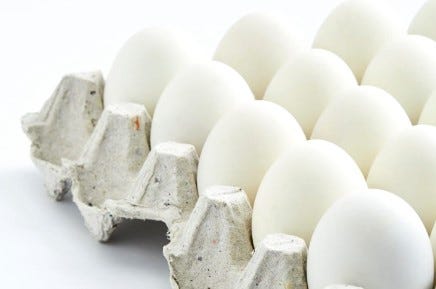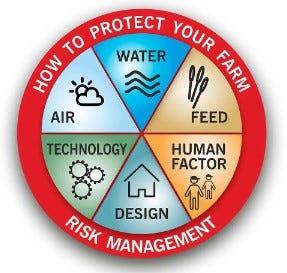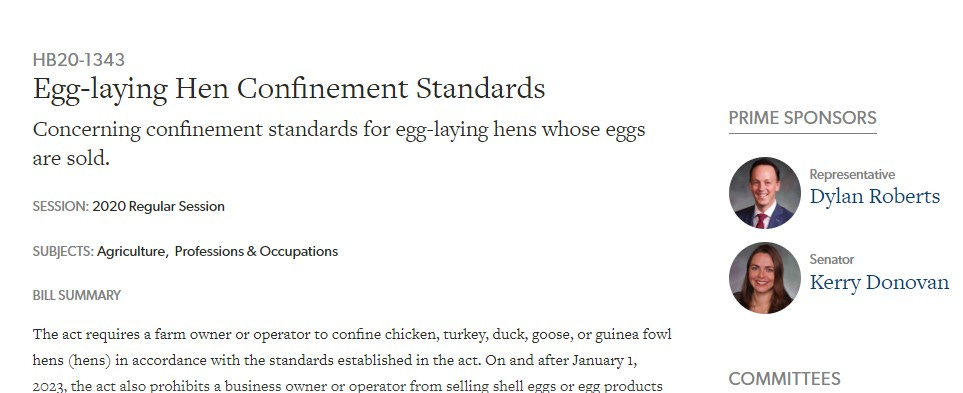A three-parter on avian flu: the loss, notes on bio security and the technical details, and some thoughts on how this intersects with Donovan and Robert's cage-free law.
An egg disaster: the scope of the problem.
Gov Polis (per the older CPR article below) recently declared a disaster in Weld County as an avian flu outbreak at an egg facility necessitated culling the flock there.
A quote gives a sense of the scale of the loss:
"Federal avian flu protocol dictates that all birds in a flock have to be humanely put down if a single case of the highly contagious virus is detected among it. In this particular outbreak, all 1.78 million chickens at the Weld County farm will have to be killed to prevent any further spread."
Disaster is an apt word to describe this. This is a problem all around: for the chickens (obviously), for the producers directly affected, for the people who got infected (see the second link below) working with birds, and possibly for dairy farms and dairy farm workers (see the third and fourth link below).
As a quick note: I want to be sure to take a minute to say that the people infected have so far not had any serious health problems and we are quite a ways from this being something that is a threat to the general population. When I say it's a problem for the workers I mean mostly in the economic sense as is certainly the case for their employers.
It will also likely prove a cost for taxpayers. The federal programs which compensate farmers and producers when a herd or flock is culled are paid for by John and Jane Q Taxpayer, you and I.
The system is so far working as it is supposed to. Public health has taken a bit of a (partly self-deserved) black eye lately, but I think something like this provides us all an example of why having disease surveillance is important. It can, when used correctly, save money and possibly lives.
Of equal importance here is the issue of biosecurity when it comes to Ag. I will take that up in post 2.
https://www.cpr.org/2024/07/08/disaster-emergency-declaration-avian-flu-outbreak-weld-county/
https://coloradosun.com/2024/07/13/colorado-three-new-casees-bird-flu/
https://coloradosun.com/2024/07/02/colorado-bird-flu-dairy-cattle/
https://coloradosun.com/2024/07/03/colorado-bird-flu-human-case-dairy/
An egg disaster: the need for biosecurity.
Let's dip into something hinted at (but not really fleshed out) in post 2 earlier: the idea of biosecurity in Ag. Rachel Gabel has written about this multiple times. She was kind enough to point me to her recent FencePost article on the topic and I link to it below.
By just parsing the word itself, you get the idea that biosecurity relates to life security. In a general sense what we're about is protecting the lives of the stock on someone's Ag operation. There is a case to be made for watching for viruses with the potential to jump to humans, but it's larger than that. Producers have a lot of money tied up in their stock, and they also don't want to see suffering. Biosecurity then is often less about protecting people than animals.
Sometimes, going back and forth to Denver, I will jump off I-76 at Roggen, stairstepping down on some county roads until I pop out I-70 at Bennet. Somewhere along in there is a chicken operation (not sure if it's eggs or birds). Even if you knew nothing about biosecurity, you might get a sense by passing this operation. There is signage everywhere about the process one must undergo even just trying to enter or leave the parking lot! Clearly, they have a lot of concern for who comes and goes.
You get a better sense of the topic by reading things by people who know more, and Gabel has done good work here (see not just the current link but the op eds in the "Related" topic below). Still, I don't think I quite had a good handle on just how careful and secure you need to be in a chicken operation.
Reading the below is startling. Trucks and people both must often be washed prior to entering the facility. Then they're given overalls (sometimes even down to different pairs for different sheds!).
It ain't just washing things either. Feed is apparently a possible vector. I'm not quite sure how (the article doesn't have a lot of technical detail), but it seems that as we learn more, feeding operations can be a source of infection, quote a problem when one feed operation may supply numerous chicken facilities.
Educate yourself on the topic if it's of interest. There's plenty more to learn and Gabel's article below is a good start (in particular, there is a lot of detail about monitoring: finding infection, a crucially important step since early detection can limit the amount of loss a producer suffers).
Post 3 is how recent policy, specifically our mandate on "cage free" eggs intersects with this disaster.
Related:
One of the few protections that we have against problems like in the articles above is strict biosecurity at Ag facilities.
The issue is often (though not necessarily the case in the Weld County outbreak -- let me be clear in saying that I've seen nothing that it was due to a lapse) that there are those that ignore these efforts or are ignorant of them.
Below are a couple older op eds by Rachel Gabel on the importance of Ag biosecurity and those that don't respect it. Good reads, cheap education.
https://www.coloradopolitics.com/opinion/gabel-state-policy-puts-farm-biosecurity-at-risk/article_d4abc97c-c80a-11ec-89b7-031157ddfc0b.html
https://gazette.com/opinion/column-threats-to-ag-biosecurity-are-multi-gabel/article_ea308cae-95f6-11ee-a8ea-5795e532ae30.html
An egg disaster: the Democrat policy.
Last thing I want to touch on today and that is how this disaster interacts with the policy of this state. In particular, I want to mention the intersection with the 2020 bill sponsored by (then) Senator Donovan and (now) Senator Roberts.
That bill was signed by Polis and I link to it below. The bill required egg producers (by 2025) to have their eggs produced in "cage-free" (as defined in the bill -- see the summary if curious) facilities. It also forbids the sale of eggs, regardless of the location of their production, that are not from hens in the same kind of "cage-free" facilities it holds Colorado producers to.
In the past, and under similar circumstances (see my earlier post linked second below) we faced price increases on eggs due to both disease AND Colorado's policy. Disease meant a shortage of chickens and the 2020 bill below meant that we artificially limited who we could buy eggs from.
Will we see similar from this disaster?
I texted briefly with Rachel Gabel on this and her take was that it was too early to tell (agreed), but she pointed out something I don't think I had considered, another corner on this issue.
The profit margins on eggs is pretty small; there isn't a huge elasticity in egg prices. Producers (like the one that lost his entire flock) have already invested heavily in meeting Colorado's law on eggs.
Put those two things together. Take the perspective of someone trying to run a business selling eggs.
Now think of how laws like the 2020 one linked below affect us all. It isn't just prices. They're bad enough. It's the pummeling producers take in this state.
Small wonder I had a friend tell me recently that his entire family is selling off their land and other assets. This state is simply not as friendly to Ag as it once was.
And that's a shame because it didn't have to be this way. We don't have to put a huge portion of the economy of this state (and one of the main supports of people who live outside the Front Range) at hazard.
Perhaps if the politicians that sponsored, voted for, and signed this bill, took the time to educate themselves and then educate their constituents instead of taking the easier, more politically expedient route of bowing to extremists, this state could work better for all.





